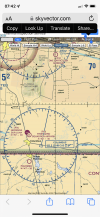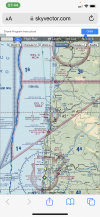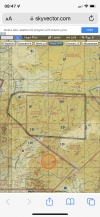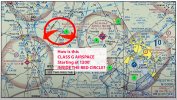View attachment 147753
Hello, pchaps. I've read your post with interest, but I'm not sure what you mean by "Class E inside my red circle."
I annotated your attachment with some numbered points to give examples. Keep in mind that the FAA has broken Class E airspace into eight different types.
1. If you are standing on the ground at Point 1, you are in Class G airspace. Class E5 directly above you starts at 1200 ft. AGL.
2. If you are standing at Point 2, you are in Class E2 (dashed magenta line) which starts at the surface, meaning you are prohibited from flying there without an authorization.
3. If you are standing at Point 3, you are in Class G airspace. Class E5 directly above you starts at 700 ft. AGL.
4. If you are standing at Point 4, you are in Class E4 airspace. This is Class E airspace area designated as an extension to a Class D or Class E surface area. You can fly here, but only up to 400 ft. AGL with caution due to the Restricted Area R-5303 immediately to the southeast of Point 4. The airspace directly above you is Class E5 starting at 1200 ft. AGL.
5. If you are standing at Point 5, you are in Class D (dashed blue line) which begins at the surface meaning you can't fly there.
Here's a link to an FAA document that you may find helpful:
https://www.faa.gov/uas/resources/e.../How_To_Understand_and_Operate_in_Class_E.pdf
Here is the current list of Class E types:
E1 - Class E airspace at and above 14,000 feet MSL.
E2 - Class E airspace areas designated as a surface area for an airport.
E3 - Class E airspace areas designated as an extension to a Class C surface area.
E4 - Class E airspace areas designated as an extension to a Class D or Class E surface area.
E5 - Class E airspace areas extending upward from 700 feet or more above the surface of the earth.
E6 - Enroute domestic airspace areas.
E7 - Offshore airspace areas.
E8 - Class E airspace areas designated as federal airways.
The only Class E type that FAA Part 107 drone operators have to be concerned about is Class E2 (14 CFR Sec. 107.41)
Best regards,

















